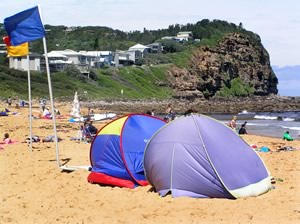National Shade Day 2011
02 September 2011
The fact that Ultraviolet (UV) radiation levels change throughout the year is generally well known, but a new Bureau of Meteorology case study demonstrates that UV levels can also change significantly over much shorter time scales such as from one day to the next.
Understanding changes to UV levels

Sunshades on a sandy beach in summer.
The fact that Ultraviolet (UV) radiation levels change throughout the year is generally well known but a new Bureau of Meteorology case study demonstrates that UV levels can also change significantly over much shorter time scales such as from one day to the next.
The case study, titled Short-Term Variability of Ozone and UV demonstrates how the passage of weather systems, particularly across southern Australia can cause UV levels to jump between categories (e.g. High to Very High, Very High to Extreme etc) which can, in turn, alter the recommended measures needed to protect people from the effects of these levels of UV exposure.
What causes variations in UV radiation?
The Bureau study established that a number of factors affect the amount of UV radiation reaching the Earth's surface – geographical location, clouds, time of day and year, as well as ozone concentration.
The circulation of the atmosphere between the polar regions and the tropics transports ozone-rich air masses in the upper levels of the atmosphere.
The passage of weather systems in the layer of the atmosphere closest to the Earth's surface, called the troposphere, can impact the transport of ozone-rich air from upper levels of the atmosphere (specifically the stratosphere).
Research has identified that an inverse relationship between ozone concentration in the stratosphere and UV radiation exists. In other words, when ozone in the stratosphere is reduced this leads to an increase in surface UV radiation.
Facts About Changing UV Radiation Levels
Source: World Health Organisation / BOM
- Sun elevation: the higher the sun in the sky, the higher the UV radiation level. UV radiation levels peak at solar noon time during summer under clear sky conditions.
- Latitude: the closer to the equator, the higher the UV radiation levels.
- Cloud cover: UV radiation levels are highest under cloudless skies but even with cloud cover, they can be high.
- Altitude: UV levels increase by about 5% with every 1000 metres altitude.
- Ozone: ozone absorbs some of the UV radiation from the sun. As the ozone layer is depleted, more UV radiation reaches the Earth's surface.
- Ground reflection: many surfaces reflect the sun's rays and add to the overall UV exposure (e.g. grass, soil and water reflect less than 10% of UV radiation; dry beach sand reflects 15%, sea foam reflects 25% and fresh snow reflects up to 80% of UV radiation).
Want to know more?
The full scientific paper can be accessed via the Centre for Australian Weather and Climate Research (CAWCR) website: Short-Term Variability of Ozone and UV: A case study


Comment. Tell us what you think of this article.
Share. Tell others.